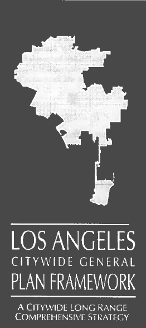What follows is former Los Angeles Planning Commission President George Lefcoe's TPR Reply to Bill Christopher's Open Letter concerning LA's proposed General Plan Framework. For the record, after one year of service, Mr. Lefcoe submitted his resignation from the Commission effective September 15, 1995.
Chairing public hearings on the General Plan Framework, and reviewing written comments about it, I am struck by the astonishing distance between what the document actually does and how a few have mischaracterized it.
Bill Christopher's Open Letter assails the Framework for not doing enough to preserve the "many, varied, and richly cultured neighborhoods." Curiously, preserving those neighborhoods, particularly those which are low density, is among the most significant features of the Framework.
The Framework based its population forecasts on numbers developed in cooperation with SCAG. Forecasts are based primarily on previous trends. Since Southern California, including the City of LA, grew in the past, those forecasts predict future growth.
The fact that the plan and its accompanying EIR embody those numbers doesn't mean those who enact the plan believe the amount of growth is salutary, or even that it will occur. The general plan is neither a fertility enhancer nor a birth control device. We are bound by state planning law to explain how we would accommodate growth if it occurred.
There are three ways to answer the question: where could increased development take place—should the need arise?
One theoretical possibility is to cast development outside the city boundaries. To some extent, this is the trend of existing development. SCAG projects that the City's population to 2010 will increase by 24 percent while the regional population grows 40 percent.
There is room for debate whether this trend should be welcomed and accelerated or fought tooth and nail. Right now, the City has a higher than average regional ratio of jobs to households. More people commute in than out. To some, this argues for encouraging moving jobs out of the City until the City and regional jobs-housing ratios are equal.
To others, the only hope for southern California to double our percentage of public transportation ridership (we would then be at the levels experienced in the Bay Area) is for there to be a more concentrated clustering of jobs and housing. Transit ridership would increase with higher densities. The greatest public investments in public transportation would increase with higher densities.
The greatest public investments in public transportation—bus and rail—are within the City's boundaries. Further, the Port and LAX are the most logical anchors for concentrated job growth in the region. To achieve higher densities, the City of Los Angeles would need more intensive development. Outside the City, there would have to be lower levels of development and maybe even an urban growth boundary.
At this point, the debate is of theoretical interest only because the SCAG numbers are the best and only basis we have at hand for any sort of regional accommodation. The Framework assumes that the City and the region will grow pretty much as they have in recent decades with higher growth rates outside the City.
For that portion of regional growth predicated to take place inside city boundaries, there are only two options: one is to increase densities throughout the City more or less evenly, and the other is to target centers and districts for that growth. The Framework selects this second option.
Putting most newcomers into existing neighborhoods in the City of Los Angeles would increase average densities 33 to 50 percent. The Framework explicitly rejects this option.
Framework Objective 3.5 seeks to "ensure that the character and scale of stable single family residential neighborhoods is maintained." The land use element of the plan is the 35 community plans. Having sat through the updating and revisions of a number of these, I can report with confidence that significantly increased densities aren't being embraced in community plans.
The Framework builds on the centers concept, refined to take into account the experienced reality of the past 20 years, that in a city dependent on auto and bus, "centers" are more likely to be linear than concentric. Growth is scheduled for certain centers and districts. Not one of those is proposed for a single-family residential neighborhood.
Solid, well preserved, stable neighborhoods aren't the natural enemies of job growth. They are indispensable to it. Every survey of business location decisions shows that firms tend to be located near where the managers want to live.
There is another side to this: good neighborhoods don't stay that way very long when the economic base deteriorates. For better or worse, business location decisions depend, to some extent, on whether business people perceive the political climate as friendly or hostile to them. The land use process is a highly visible part of that perceived political milieu.
The Framework seeks to protect neighborhoods by guaranteeing their sanctity against higher density intrusion. The Framework stands for both good neighborhoods and job growth in a thrivng economy since it is impossible to have one without the other.
- Log in to post comments




